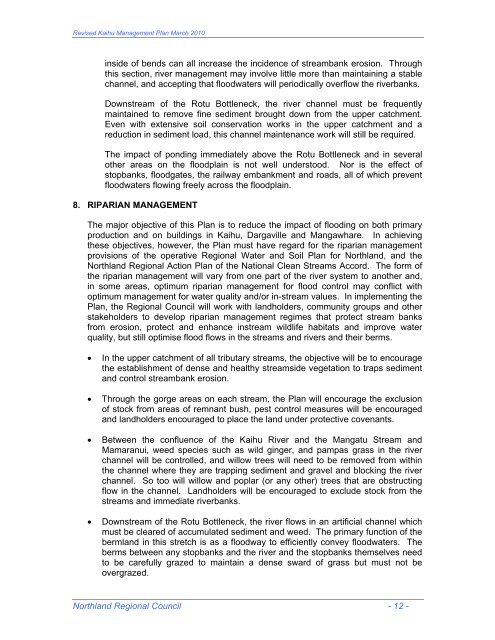draft revised kaihu river management plan - Northland Regional ...
draft revised kaihu river management plan - Northland Regional ...
draft revised kaihu river management plan - Northland Regional ...
- No tags were found...
Create successful ePaper yourself
Turn your PDF publications into a flip-book with our unique Google optimized e-Paper software.
Revised Kaihu Management Plan March 2010inside of bends can all increase the incidence of streambank erosion. Throughthis section, <strong>river</strong> <strong>management</strong> may involve little more than maintaining a stablechannel, and accepting that floodwaters will periodically overflow the <strong>river</strong>banks.Downstream of the Rotu Bottleneck, the <strong>river</strong> channel must be frequentlymaintained to remove fine sediment brought down from the upper catchment.Even with extensive soil conservation works in the upper catchment and areduction in sediment load, this channel maintenance work will still be required.The impact of ponding immediately above the Rotu Bottleneck and in severalother areas on the floodplain is not well understood. Nor is the effect ofstopbanks, floodgates, the railway embankment and roads, all of which preventfloodwaters flowing freely across the floodplain.8. RIPARIAN MANAGEMENTThe major objective of this Plan is to reduce the impact of flooding on both primaryproduction and on buildings in Kaihu, Dargaville and Mangawhare. In achievingthese objectives, however, the Plan must have regard for the riparian <strong>management</strong>provisions of the operative <strong>Regional</strong> Water and Soil Plan for <strong>Northland</strong>, and the<strong>Northland</strong> <strong>Regional</strong> Action Plan of the National Clean Streams Accord. The form ofthe riparian <strong>management</strong> will vary from one part of the <strong>river</strong> system to another and,in some areas, optimum riparian <strong>management</strong> for flood control may conflict withoptimum <strong>management</strong> for water quality and/or in-stream values. In implementing thePlan, the <strong>Regional</strong> Council will work with landholders, community groups and otherstakeholders to develop riparian <strong>management</strong> regimes that protect stream banksfrom erosion, protect and enhance instream wildlife habitats and improve waterquality, but still optimise flood flows in the streams and <strong>river</strong>s and their berms.In the upper catchment of all tributary streams, the objective will be to encouragethe establishment of dense and healthy streamside vegetation to traps sedimentand control streambank erosion.Through the gorge areas on each stream, the Plan will encourage the exclusionof stock from areas of remnant bush, pest control measures will be encouragedand landholders encouraged to place the land under protective covenants. Between the confluence of the Kaihu River and the Mangatu Stream andMamaranui, weed species such as wild ginger, and pampas grass in the <strong>river</strong>channel will be controlled, and willow trees will need to be removed from withinthe channel where they are trapping sediment and gravel and blocking the <strong>river</strong>channel. So too will willow and poplar (or any other) trees that are obstructingflow in the channel. Landholders will be encouraged to exclude stock from thestreams and immediate <strong>river</strong>banks.Downstream of the Rotu Bottleneck, the <strong>river</strong> flows in an artificial channel whichmust be cleared of accumulated sediment and weed. The primary function of thebermland in this stretch is as a floodway to efficiently convey floodwaters. Theberms between any stopbanks and the <strong>river</strong> and the stopbanks themselves needto be carefully grazed to maintain a dense sward of grass but must not beovergrazed.<strong>Northland</strong> <strong>Regional</strong> Council - 12 -
















